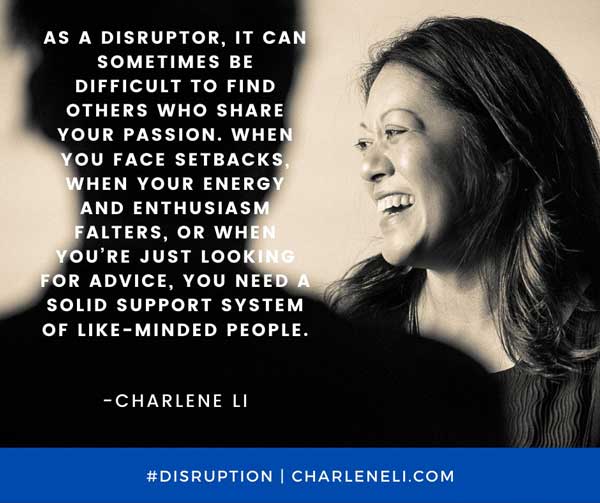Before the coronavirus and its associated recession, digital transformation at most companies was a near-term objective. Now, it’s an immediate strategic requirement. As companies bounce back after the pandemic shutdown, many are moving faster to modernize their IT while others are figuring out how to choose the right technologies and skills to thrive in a new, uncertain economy. Charlene Li, author or co-author of six books on leadership and transformation – including her latest, The Disruption Mindset –has blunt advice for all of them: The only way to get out of the present crisis is to think beyond it.
“The secret to the disruption mindset is … thinking about the future,” said Li, a senior fellow at consulting agency Prophet, whose clients include Marriott, Alteon Health and Chick-fll-A, just to name a few.
According to Li, most companies seek disruption in order to drive growth when in fact growth itself is disruptive. The companies that emerge successfully from the pandemic, therefore, won’t focus only on new technologies; they’ll also focus on new opportunities.
“I can spend two hours walking through every technology in the world, and you’ll be exactly where you are today,” Li said. “Or we can spend two hours trying to figure out how you’re going to grow and where the opportunities are, and really diving deep into who your customers are. Then we can face the hard, cold reality that you have no idea how to actually do that. That’s disruption. You’re going to change so much in order to meet those needs.”
The New ‘New Normal’
Li said that half the people she’s spoken to recently are uncertain about the future. In fact, many business leaders are so overwhelmed by the current pace of change that they don’t feel confident thinking beyond the next 30 days. They claim to be waiting for a “new normal” when in reality they’re holding out for a return to the old one.

“They’re not exploring how things have fundamentally changed,” Li said. She often sees companies make one of two critical mistakes when it comes to transformation: Either they keep steering in the same direction – i.e., they continue to pursue their pre-pandemic goals – or they let go of the wheel entirely in order to recalibrate and redefine their way forward.
The former believe they can plan their way through disruption and make everything work smoothly by engineering it ahead of time. By definition, however, disruption never goes according to plan.
“You can get banged on the side of the head with something you didn’t anticipate because you just weren’t curious,” Li said. “You didn’t ask, ‘Are my assumptions of the world still true?’”
In the face of chaos and uncertainty, they often aren’t. In that event, planning can seem pointless. And yet, it’s actually more important than ever, insists Li. She said the most successful companies triumph in challenging times not because they lack a plan, but because they have multiple plans that help them adapt to significant changes quickly without losing focus on their customers.
Customers First, Especially at Crossroads
Having a customer-centric mindset can help companies find the right compromise between too much planning and too little, according to Li. She observed the importance of customer experience firsthand in the newspaper industry, where she served on the board of Knight-Ridder and worked with The Poynter Institute.
She pointed out that the newspaper industry in the 1990s failed to create new value for new customers. When online classified ad company Craigslist hit the scene, many newspapers responded by making their own printed classifieds free. Instead, Li said, they could have created better-than-Craigslist online classified services that customers would pay for.
Newspapers clung to their printed product when they should have been searching for new ways to add value beyond it. In that way, Li said, the disruption mindset requires “really, truly understanding who your customers are and how you can meet their needs” by looking at the market from the customer’s perspective instead of the company’s.

Li sees the meetings and events industry at a crossroads today that’s similar to what the newspaper industry faced in the 1990s. The impact of COVID-19 and social distancing measures have forced meeting planners not only to move their events online, but to fundamentally rethink what value their events can offer attendees in an increasingly uncertain future. For example, will attendees who previously wandered exhibit halls at face-to-face meetings feel incentivized to similarly mingle with virtual exhibitors?
Li doesn’t think they will. And without that opportunity, meetings might lose sponsors.
“[Meetings are] a three-sided platform: content, audience and sponsors,” Li said. “How can you deliver the value all three need?”
If they were building their industry from scratch today on the internet, event planners would never conceive of people having to attend at a specific day and time online, she said. So event planners must identify what to abandon and what to enhance in order to keep online audiences engaged and inspired.
But that’s not all. Li said now also is an ideal time to also think about future audiences, which may attend meetings in person, online or through another medium entirely.
“Do you know who your future customer is?” Li asked. Knowing the answer is more important than ever.
Plan B…and C and D
Companies that succeed at digital transformation have at least one thing in common, according to Li.
“They have a lot of process and governance and structure,” she said. “Not to the extent to keep people from doing anything, but the opposite. When you know exactly how work is going to get done, you don’t focus on that. You can focus on your big, audacious new goal.”
At those companies, Li observed, leaders approach transformation by:
Admitting they don’t know what’s going to happen
Identifying several radically different potential scenarios
Developing a strategy for each of them; and
Establishing trigger points to help them recognize when things are moving from one scenario to another so they can execute on the appropriate plan
In other words: Enterprises must be proactive before they’re reactive. Li said companies that respond to change only by making cuts are merely postponing their demise. Instead of riding out the storm, smart organizations will recognize this as the ideal time to reexamine and re-evaluate everything, including who their customers will be going forward.
Rather than relying on a single post-pandemic plan, or no plan at all, successful companies will plan ahead for every credible possibility, no matter how radical.
“It’s a good time to blow everything up,” Li said, “because it’s already been blown up.”
Paul Boutin is a contributing writer. Find him on Twitter @paulboutin.
© 2020 Nutanix, Inc. All rights reserved. For additional legal information, please go here.


